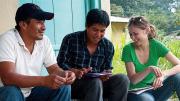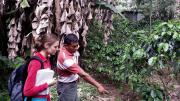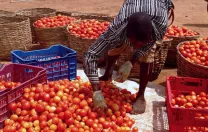In an idealized business transaction (ignoring restraints on competition and marketing blandishments), willing shoppers choose the products and services they want, and companies measure their sales, cash flow, profits, and return on capital—financial metrics that managers and investors alike can assess.
But how should social impact be evaluated? In “Business at the Base of the Pyramid” (see main article), students contend with the relative worth of enabling lower-income people to exercise consumer sovereignty (buying a television) versus securing their access to medicines. They consider research suggesting that microfinance—a high-profile tool in development economics and a vehicle for base-of-the-pyramid “financial inclusion”—often appears to bolster consumption more than it enables entrepreneurship, arguably a higher-impact goal.
A broad, deep effort to develop methods for measuring social impact exists in Cambridge’s Central Square, just down Massachusetts Avenue from Harvard Yard. Root Capital (www.rootcapital.org), a nonprofit founded in 1999, lends to small agricultural enterprises—for example, Latin American coffee cooperatives—that need funding beyond the smaller loans offered by microfinance institutions, but are not yet served by commercial banks. Such enterprises provide vital rural services to hundreds of member growers, but are financially stuck in the “missing middle.” To date, Root Capital has disbursed more than $900 million in loans, focusing on producers of high-value, traded products such as coffee, cashews, and cocoa, but also extending of late to smaller growers of local, staple crops in Africa.
Does Root’s lending make a real difference? Brian Milder ’01, M.B.A. ’07, the senior vice president who oversees strategic planning, financial advisory services for clients, and innovation, also directs impact assessment. He outlines three principles. The deepest in-field assessments (see below) ought to be client-centric: not merely generating information for external parties, but engaging clients in a process that results in better growing and operating practices. Assessment also aims at determining “additionality”: measuring the real impact from, say, Root’s agricultural lending versus what would happen in the market were Root not making funds available. Finally, in Root’s vision, there ought to be a balance between impact and financial investment decisions, with both considerations playing a role at a loan’s inception. (For Root, that balance has been shifting in interesting ways; as its clients have grown to need larger and longer-term loans—not just to finance a season’s crops but to build processing facilities, for example—hoped-for bank financing has not been forthcoming, so Root has stepped in. On such loans, it aims to make a profit, following the commercial model, in order to subsidize lending to smaller borrowers—where it is not able to cover its costs.)
Mike McCreless, M.B.A.-M.P.A. ’10, director of strategy and impact, says those principles shape the criteria loan officers use in the field. Given Root’s goal of supporting rural entrepreneurs and rapid economic growth, he said, “We had to figure out how to direct money to where it has the most impact” on local investment: boosting farmers’ income by obtaining higher prices for their produce, and so on. Root’s website and quarterly and annual reports display data on the number of producers affected, women farmers benefited, acreage under sustainable cultivation, and so on—alongside accounting for loan balances and performance.
Of late, those analyses have been supplemented by deeper, almost ethnographic studies. Impact officer Asya Troychansky ’07, for example, visited four Root client coffee cooperatives in Guatemala, interviewing their managers and staff, and training four local consultants who in turn surveyed 407 farmer-members and 233 nonmembers, seeking to tease out their relative incomes, production practices, and other outcomes—and the connection to Root-supplied financing. She found that in effective cooperatives with Root funding, membership was associated with higher incomes, in part because the co-ops could pay growers a base price during harvest—reducing dependence on intermediaries that customarily buy at prices less advantageous to the farmers. Enabling co-ops to pay farmers earlier contributed to a virtuous cycle of higher membership, with member farmers able to take advantage of the cooperatives’ services, including agronomic training that promoted wider use of sustainable practices. Troychansky also gathered evidence on gender inclusion and agricultural environmental impacts—data in place of suppositions, facts by which to direct lending.
Beyond its Root-focused work, Milder’s team works to advance assessment tools generally. One locus is the Global Impact Investing Network, with its impact reporting and investment standards (IRIS): an effort to evolve what he calls an impact “taxonomy” equivalent to Generally Accepted Accounting Principles for financial statements. McCreless, who has driven, and disseminates, some of this work through a blizzard of journal articles and papers on impact assessment, says the measures get at types of impact (income, for instance); scale (the affected population); and depth (the level of impact on each person). Much of Root’s information on impact types and scale comes from loan officers’ reports; depth metrics are least developed. That is where Troychansky’s studies come in. “The metrics are the starting point,” she says. The field studies aim at a “more holistic impact profile” of lives likely changed.
Whatever tools are finally evolved, Milder puts their importance in a larger context. “Business at the Base of the Pyramid” (which he took in 2007) describes the world as a triangle, but from Root’s perspective, he says, the relevant image is a snowman—perhaps ironically so, given the warm regions where Root works. “Think of the 450 million to 500 million smallholder farm families in the world,” he explains: the 2 billion to 2.5 billion people who till less than 5 hectares, and who are perhaps three-quarters of the world population living on less than $2 per person per day. The top 10 percent of this group (the small head) are in organized supply chains for cash crops like coffee or cocoa—and Root and similar organizations are beginning to get them the capital they need. Mid-body are the 150 million to 170 million semi-commercial farmers who grow and sell staples. And at the bulging bottom are the marginal, subsistence farmers, who just manage to survive working their land.
In agriculture, Milder says, the need for investments with beneficial social impact is far greater than anyone envisioned when Root was founded. In human needs, business opportunities, and prospective impact, the same holds true across the entire base of the pyramid.











